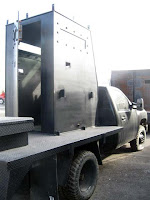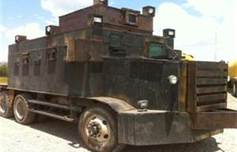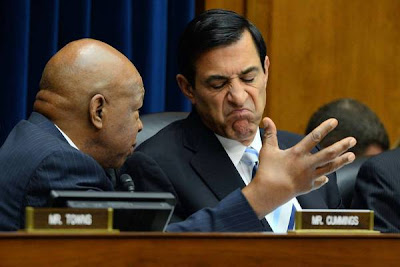Rio Doce. 6-18-2012
The threat of death squads that are formed inside police organizations once again terrifies families of victims of disappearances in Sinaloa. In the midst of the chaos that public safety is experiencing, the public not only fears the criminal groups but also mistrusts the institutions charged with protecting them.
At least in Culiacan and Los Mochis there have been reports in recent weeks that state and municipal police officers have allegedly participated in abductions disguised as arrests that end up as executions that sharpen suspicions that public safety agencies are using the same tactics as organized crime.
This is the case with four youths detained on March 29, 2012, by state police officers in the Adolfo Lopez Mateo neighborhood , according to investigation Case Number CLN/ARD/5373/2012 filed with the Department of Justice, Northern Zone.
The complaint states that Jesus Fernando Urrea Vega, age 20, and Jorge Armando Manjarrez, aka "el Guerito", a minor, were repairing a vehicle outside the home of Urrea Vega when five State Police patrol vehicles came to the scene.
The police officers told them they wanted to ask routine questions, but they violently put all four youths in one of the patrol units., covering their faces with the shirts the detainees were wearing. The mother of Jesus Fernando Urrea Vega, who witnessed the arrest, questioned them about the detention but did not get a reply. They were never heard from again.
According to the complaint, the police officers then went on to arrest the brothers Luis Eduardo and Jesus Angel Ontiveros Campos, 17 and 21 years old, respectively. The first youth was picked up at a soccer field and the second youth was picked up at his home in the same neighborhood.
With respect to this incident, three weeks after the abduction took place, relatives and friends of the victims protested in front of the Department of Justice building, demanding information and justice for the individuals. The protesters, most of them workers with the Culiacan city maintenance department, complain they have been denied information in all the public safety offices, where there has been total silence on this case.
Based on statistics from the human rights commissions and records in the State Department of Justice, 285 persons have disappeared in Sinaloa from 2008 to date, but the true number of this type of crime is not known.
An alarming fact, made known by the Sinaloa Human Rights Commission is that just on February 12, 2012, there were reports of 20 abductions ("levantados"-- picked up) in the state, currently considered to have disappeared ("desaparecidos").
That day, there was a report that Edgar Guadalupe Garcia Hernandez, 24 years old, a messenger in the office of prosecutor Marco Antonio Higuera Castro, was picked up and disappeared. A group of armed men abducted him from his home in Colonia Progreso, in Culiacan. Relatives and friends of Garcia Hernandez protested in front of Cathedral, in Culiacan, on May 31, demanding that authorities investigate this violent incident.
Offering his opinion on abductions that turn into disappearances or executions, the State Secretary of Public Safety, Francisco Cordova Celaya, noted that members of crime groups use clothing that resembles the uniforms worn by the military and other law enforcement agencies, in order to confuse people. He disclosed that they have seized vehicles cloned to look like patrol vehicles and both state and federal enforcement agencies are investigating the fabrication of bogus clothing and comparing the seized firearms to determine through ballistics [tests] whether they have been used in other crimes.
"All the vehicles from the different police agencies, including the officers, are perfectly identified so that the population can tell them apart from fake policemen or military personnel," he stated.
Death squads?
In Los Mochis, death squads were created with the arrival of Jesus Carrasco Ruiz to the Ahome Municipal Police, declared grieving relatives of two young men in the community of Jose Maria Morelos de Los Mochis, Ahome.
Along the same line, the case of a young couple of scrap metal pickers who ended up being murdered in the cemetery of the Ahome community, about 20 kilometers (12 miles) west of this city, reveals who their executioners were: police officers.
All four homicides were committed in June and perpetrators fit one pattern, the victims another. With respect to the perpetrators: police officers, municipal police, Los Mochis preventive police officers, to be more specific, and the victims: neighborhood friends, members of the same clan.
In the four murders, which began as arbitrary detentions, both the State Human Rights Commission, Northern Inspections office, and the Agency Specializing in Intentional Homicides initiated respective investigations.
The Northern Zone Inspections office has reports that show that in just the first semester of 2012, police abuse complaints tripled, mostly in Los Mochis. That period coincides with the appointment of ministerial police officer Carrasco Ruiz to lead the Police and Traffic agencies in Ahome, a position for which he was considered unqualified because he lacks a university degree, which is an essential requirement.
The scrap metal pickers
In late May and early June, scrap metal pickers Marcelo Felix Armenta, age 27, and Yolanda del Carmen Araujo Felix, 26 years old, both residents of Las Grullas Margen Izquierdo, disappeared. The only clue they left as to what happened to them was a telephone call. They had been detained by Ahome municipal police officers, [they said]. After that call, their cell phones went dead, their surviving relatives told the State Human Rights Commission. Eight days later, their bodies were found in the town's cemetery. A shot to the head had ended their lives.
The motorcyclist
The night of the first Sunday in June, Jose Felipe Alvarado Juarez, aka "El Pelochitas", 20 years old and resident of Jose Maria Morelos Street, was riding his motorcycle when two municipal police patrol vehicles picked him up. He was placed in one unit and the motorcycle in the other.
Witnesses to the detention, because the young man was very well known in the area around that police station, called his mother, Yadira Juarez, who had just left work and was walking home, located less than 300 meters from the police station.
Witnesses say that both patrol vehicles entered into the station yard, carrying both the motorcycle and the detainee in the back of the pickups.
In just a few minutes his mother arrived at the station to inquire about her son, but nobody would talk to her. Five hours of uncertainty went by before a police officer who was guarding the patrol yard entrance told her that the bike was on the grounds. Dawn came and her son had not come home. Again she went to the police offices but nobody would talk to her.
She filed a complaint with the Northern Zone office of the State Human Rights Commission and the director called Juan Lopez Cardona, admissions judge, who denied the youth was under arrest. He took her (the mother) to the holding cell area, and in fact, her son was not there. She went here and there, but got nothing done.
Two days later, the body of "El Pelochitas" was found in a drainage ditch. He had been tortured, she says, and she never again saw him alive because they gave him back in a sealed casket. Sisters of the deceased say that he was dragged, punctures all over his body and strangled. During the funeral, municipal police patrol vehicles and two white colored units, which are now known to be the convoy for chief of police Jesus Carrasco Ruiz, harassed the mourners, even during the funeral mass.
"That dirty dog, he believes he has the power to take lives. F--ng incompetent government that we have. What's the use of all those laws, all those jails, all those ministries, when cops have become murderers, sons of b---s. Even if my son were the worst sort of criminal, he had the right to a trial, and if he got sentenced to rot in jail, that would have been just, because he would have been able to defend himself, but with murderers with uniforms patrolling the streets, nobody's safe," condemns the mother.
The grieving mother is looking for answers and finding them among her son's friends.
"M'am," they told her, "the cops stop us all the time. They take us to the holding cells and beat us up. They accuse us of being "halcones" [lookouts for narcos]. They're looking for 'El Trolo'."
Who is "El Trolo"?
The unemployed man
Victor Alonso Gil Aguilar, 20 years old, aka "El Chihuili," long known to the police because the previous year he was apprehended while driving a stolen car, was awakened next to his wife by the loud noise his front door made when it was torn from its hinges. When he opened his eyes, there were six cops in front of the couple. All were hooded.
"Stay calm," they told his wife, who reacted to the intrusion by taking her daughter in her arms. "Nothing will happen to you," they assured her. Then they tied her to the bed with plastic ties. They blindfolded her so she could not see anything and be able to identify them afterwards. They left her daughter beside her on the bed.
He asked, "What about me, boss?"
They answered with a question, "What do you do for a living?"
"Nothing," answered El Chihuili.
And they picked him up. They took him away in two patrol vehicles and a white colored pickup. It was 12:00 noon, the sun heavy as lead, the second Sunday in June. There was one thing for certain; they were police officers, because even the unit numbers were covered and the pickups did't have license plates.
After the police left, the neighbors on Alejandro Pena Street, in the Colonia Rosendo G. Castro, came to the dwelling and released the young woman. She fled. She looked for her family, first, then looked for her mother in law. With tears and anguish, she told them what had happened.
Desperate, Dora Alicia Aguilar looked for her son. She couldn't find him anywhere. She reported the case to reporters, but only a single news service and a small newspaper published her case. The larger ones and the one with the largest circulation were silent.
The nest day, El Chihuili's decapitated body was found in the community of Primero de Mayo. His head was used to anchor a placard that had two words: "Sigues Trolo". ("You're next, Trolo.")
The two youths grew up in the same neighborhood of the Jose Maria Morelos community; and their funeral was also in the same neighborhood; they had friends in common, among them El Trolo, because like them, he hung around the same streets.
El Trolo
According to Municipal Police and the State Ministerial Police internal reports, made public before these latest executions and beheadings, El Trolo turns out to be the chief of the
halcones (look outs) for the "Mazatlecos", a local drug distribution gang for the Beltran Leyva cartel. He is in charge of paying for the "narcomantas" (banners with messages) in which chief of police Jesus Carrasco Ruiz and State Ministerial Police commanders are accused of working for the Sinaloa cartel.
The reports released at the time were part of the testimony given by Eduardo Gonzalez Rodriguez, aka "El Yampool" or "La Thalia", and Jose Pablo Ramirez Galeana, aka "El Pinguino", both working as "polveros" (suppliers) distributing drugs to the pushers working for Jesus Miguel Pacheco Samaniego, aka "El Pecas", or "El Manchas", or "El Junior."
The list of abuses
Maria Araceli Sepulveda Saucedo, investigator in the Northern Zone of the State Human Rights Commission, declared that from January to June, 2012, police abuse against civilians has tripled, judging by the reports. She characterized the situation as "worrisome." More so when two cases that began as arbitrary detentions ended as murders, because "they went from violations of liberty rights to serious violations against the personal integrity of the victims, and there is a third case involving two deaths that are similar; attacks by police officers."
She stated that inquiries have been initiated with all the seriousness and speed called for but she lamented that the results were not what the complainants wanted. There are serious obstacles to getting substantial results: the complainants cannot identify the patrol vehicles that took part in the incidents because the vehicles lack identification numbers, since they were taken off or covered, and the police officers covered their faces with hoods.
When asked about this in the course of the investigation, Chief Jesus Carrasco Ruiz simply and baldly denies that his agents did anything. "He always answers that there were no operations, that they detained nobody and that he knows nothing about those cases. The situation is demoralizing," she said.
The number of complaints
Month: State Police: Municipal Police
January 2 3
February 3 18
March 5 10
April 4 10
May 4 12
June(13)
1 4 Total: 19 57
Cloned patrol vehicles
Two narcomantas intended for military authorities and the Government of Sinaloa showed up the evening before the weekend. One was hung on the perimeter fence of the Gregorio Torres Quintero primary school, located on Alelhies (Street), between Military College and Zacatecas (streets), west of Los Mochis; the other one was hung on Pedro Anaya (Street), between North 1 (highway) and Emiliano Zapata (street). They accuse interim Chief of Municipal Police, Jesus Carrasco Ruiz of "murdering innocents" and they ask Governor Mario Lopez Valdez (aka "Malova") and military authorities for protection from the police official.
The Chief of Police, questioned by reporters at the city hall, denied the accusations on the signs (mantas) and the complaints from surviving relatives. "We didn't pick up anybody, and the patrol vehicles could be clones, " he responded.
He admitted that his office had received some inquiries from the Civil Rights Commission, which is why he could not discard the possibility that some criminal group could be impersonating police officers using false patrol vehicles. What is involved, he added, are complaints by relatives of individuals who are purportedly detained by Municipal Police officers and are later found murdered.
"There is a good possibility," he pointed out, "that an organized crime group operating in this area has "cloned" police vehicles and uniforms to carry out this type of abductions."
In support of the statements made by his chief of public safety, the mayor of Ahome, Zenen Xochihua Enciso, denied that the Municipal Police and organized crime groups are working together. He called for people not to rely on information coming from criminal groups, because "that's not a reliable source and it impairs trust in the authorities."
"We should not get into the situation of playing along with complaints or "mantas" or conditions imposed by criminals," he said, " because if we start to doubt the actions and integrity of our officials and public servants based on accusations made by a criminal, well, we're really in bad shape if we give them any credence at any point in time."

























































